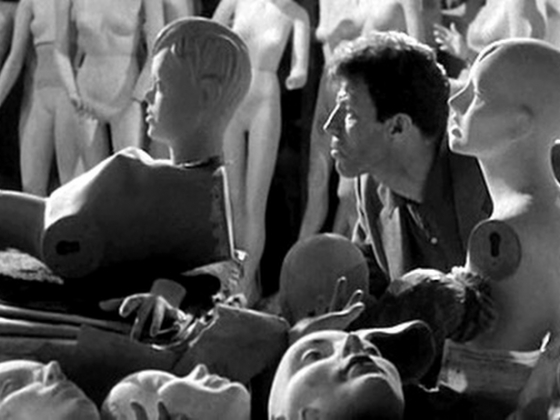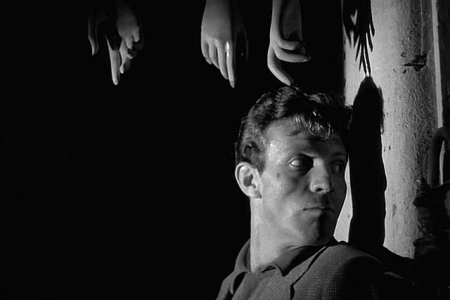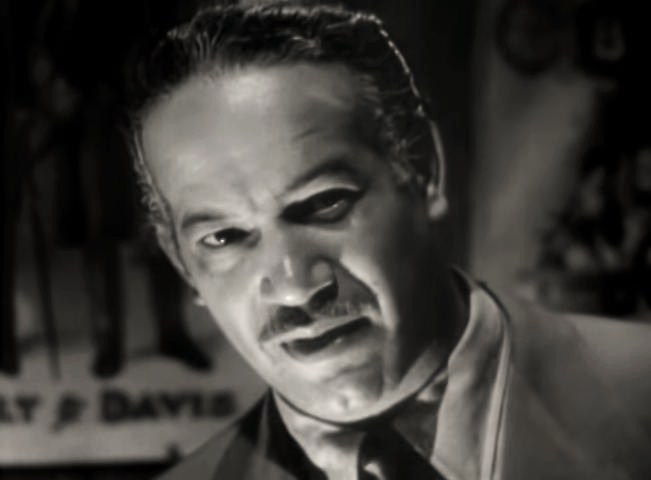
It doesn’t take long to realize that Killer’s Kiss is not a typical film noir. Although it begins with a typical voiceover, the look of the film is much, much more modern than we expect for a 1955 film. That’s the case when the film opens dramatically at the train station, then when we see a face through a fish tank and a reflection in apartment mailboxes. We notice an unusual amount of silence, with no dialogue for long stretches when the characters are being introduced. The innovator is none other than Stanley Kubrick; Killer’s Kiss, shot on New York City locations on an ultra-low budget, was Kubrick’s second feature, a calling card that he leveraged into the Hollywood support needed to make The Killing, Paths of Glory, Spartacus, Lolita and Dr. Strangelove: or How I Stopped Worrying and Learned to Love the Bomb over the next eight years.
The story is pretty simple – an unlucky boxer (Jamie Smith) falls for the girlfriend (Irene Kane) of a gangster (Frank Silvera), and the gangster just isn’t going to give her up. In another groundbreaker for 1955 cinema, the crime lord is Black and his lover is White – a point that Killer’s Kiss never explicitly addresses or even treats as unusual.

The close up preparation for the boxing match and then the fight itself remind us of Raging Bull; (Scorsese must have picked up some tips from Kubrick). Unfortunately, our boxer has a glass jaw (and he should have figured it out earlier in his career). He should have also figured out that the femme fatale isn’t worth the risk, but, hey, it’s a film noir, so he is destined to go All In on her. When she pleads for her own life (not the boxer’s), the gangster replies, “What do you take me for, a 14 karat sucker?”.
Killer’s Kiss’ crisp 67 minutes climaxes in a rooftop chase scene through the warehouse district, accompanied only by drums on the soundtrack. The protagonist and the villain corner each other in a warehouse filled with manikins, and armed with an axe and a gaff, they fight to the death. One of these guys is a professional fighter and the other is a professional killer, so they are formidable; but their weapons absurdly evoke a medieval clash between a halberd-wielder and a pikeman. Adding an even sillier aspect to the duel, when the combatants miss each other, they hack and slash the manikins.
Killer’s Kiss was the only memorable role for Jamie Smith; his performance as the boxer is adequate, up to the regrettable voiceover at the end.
As the movie’s source of conflict, Irene Kane brings a cool, willowy appeal, along with a notable disinterest in personal loyalty. Kane retired after only 6 screen credits. Then, as Chris Chase, she became a writer and co-authored autobiographies of Rosalind Russell, Alan King, Josephine Baker and Betty Ford.
In contrast, the Jamaican-born Frank Silvera had a prolific career. Silvera played a variety of races, African-American, Italian-American, even Polynesian in the 1962 Mutiny on the Bounty. Two of his most memorable roles were Latino characters, Don Sebastian Montoya in TV’s High Chaparral and Lobero in The Magnificent Seven. Silvera was a successful theater director and early civil rights activist; after his death, Morgan Freeman and others founded the Harlem-based Frank Silvera Writer’s Workshop Foundation.

Kubrick’s touches make Killer’s Kiss a transitional film – either among the last of the noir or the first of the neo-noir. I catalogue Killer’s Kiss and Elevator to the Gallows as noir and Blast of Silence as neo-noir, but it would be reasonable to go either way on each of them.
Killer’s Kiss can be streamed from Amazon, iTunes, YouTube and Google Play.
